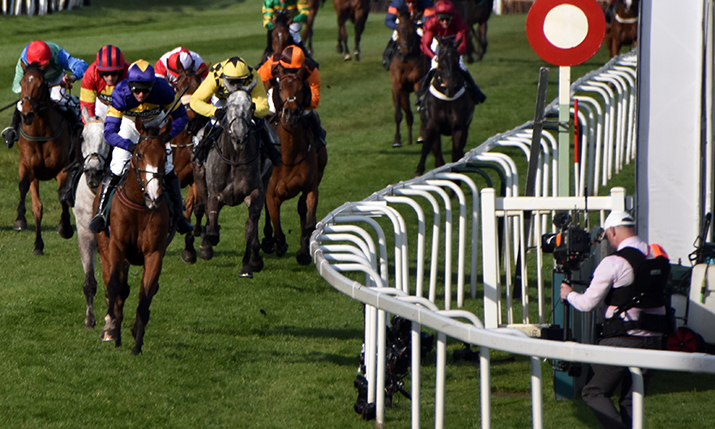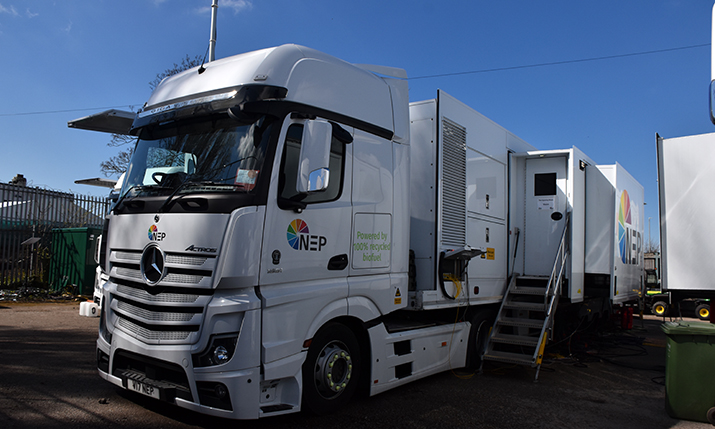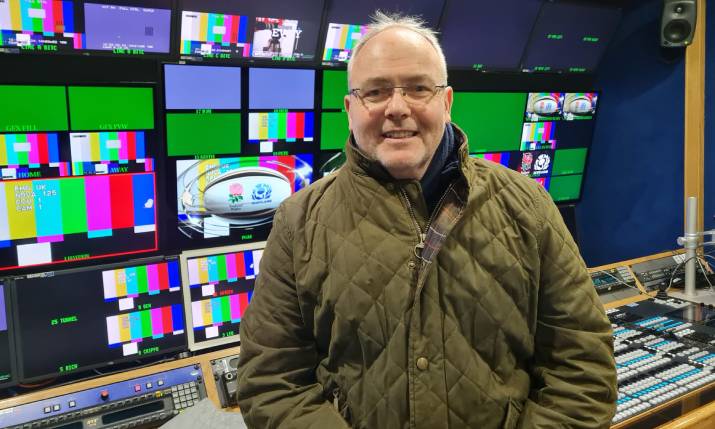ITV Racing under starters orders live at the Grand National Festival

The Grand National 2023 winner Corach Rambler passing the post
The world’s most watched horse race comes to screens once again this weekend courtesy of the thoroughbred BAFTA-winning ITV Racing team.
At Aintree, Liverpool, UK, the broadcaster is in the middle of producing five live races a day of top-class action across the three-day festival, with an extended show on Grand National Day, this Saturday [13 April 2024].
“It’s a massive part of our sports portfolio,” says Tony Cahalane, technical director, ITV Sport. “The Grand National is the most watched race of the year and then the rerun that we produce 20 minutes later is the second most watched race of the year. Its heritage is ingrained in British public consciousness so we are hugely honoured to cover it. With that in mind we cover the race with as much integrity, innovation and skill as we can.”
Safety first
Around 7.5 million UK viewers are expected to tune in to see if last year’s victor Corach Rambler can replicate the achievements of Red Rum and Tiger Roll in winning back-to-back Nationals.
The 176th running of the showpiece event offers a £1 million purse for the winning steeplechaser. ITV Racing will broadcast coverage on ITV and STV and simulcast on ITVX. The Opening Show is on ITV4 each day and ITV1 on Saturday. Oli Bell hosts a preview of the big races and takes in the morning action around the course. Ed Camberlin takes the reigns in the afternoon. Sir Anthony McCoy and Ruby Walsh join the analysis on Saturday for the big race which will under starters orders 75 minutes earlier than usual.
The race itself is being run at 16:00 BST rather than the later 17.15 slot as one of a number of logistical changes to improve animal welfare, which also includes reducing the number of runners in the race from 40 down to 34. Following a review of last year’s race, which was delayed due to protestors storming the racecourse, the later start time is intended to give the steeplechasers softer ground (in good weather the ground gets harder over the day and therefore the faster the horses will run). The first fence has also been moved forward by 60 yards nearer to slow down the pace at which the horses approach it.

NEP’s Atlantic OB unit was used for The Opening Show and Grand National re-run last year
Technical rig
ITV technical partner for the race, NEP, saw its trucks arriving at Aintree last Saturday with a technical rig beginning Sunday evening and in earnest on the Monday. The first couple of days set up are mostly concerned with rigging and checking the vast fibre cable infrastructure across the course.
“There’s a lot of pre-testing done and re-establishment of circuits and fibres,” says Cahalane. “Over the years we’ve tried to modernise that infrastructure but it’s an awfully costly exercise to do all in one go. We inherited some cable [from past broadcasters] which we can no longer use since everything is now fibre-based. So there’s a lot of checking and making sure everything is solid before we really start to put the kit out.”
Recent weather over Aintree, as across the rest of the country, has not been optimal with strong winds delaying set up of the wire-cams across the course.
Race production is split between two trucks for resiliency. “If we lost one truck we can still maintain a world feed output for the more than 200 million worldwide viewers. It’s our responsibility to make sure the feed actually gets to those 200 million viewers,” adds Cahalane.
A third truck is dedicated to the rerun, a unique part of the Grand National where immediately after the live race finishes, a detailed analysis, led by Ruby Walsh alongside Oli Bell, is played back, fence by fence, showing how the race unfolded.
“When we when we first took over the horse racing, everyone seemed to think the rerun was a bit chaotic – not on-screen, but behind the scenes – so I talked to people and decided to strip it back to basics and rebuild it,” says Cahalane.
“It sounds simple but the key thing was understanding that the rerun is a huge one-off live event in its own right and you can’t just rock up on one Saturday a year and expect everything to go according to plan.
“We needed a run-up to it. The first thing we changed was to start rehearsal of the rerun in anger on the Thursday then the Friday offline [not broadcast] based on other races like the Foxhunters’ Open Hunters’ Steeple Chase that run the National’s course. Through that experience we’ve also been able to cut out some of the stuff which we felt wasn’t really contributing anything. Again, that’s not on screen so much as just part of the workflow that wasn’t required or needed a tweak. We’ve managed to hone it so that by the time Saturday comes we all know exactly what we’re doing.”

Chief technical officer at ITV Sport, Tony Cahalane
Preparation and planning
ITV Sport programme director Paul McNamara says they begin a dialogue with Aintree as early as October. “You can’t take anything for granted. If you rock up planning on putting your opening show position in a certain place you might find they’ve introduced a new concessions stand or a Champagne bar has popped up right in the back of your shot.
“We give Aintree as much information as we have, and they give us as much information by return or what their aspirations are. Every square foot is precious for them and they obviously want to maximise its value. The dialogue which we have with all the race courses is good so that when we roll up there are no surprises on either side.”
Coverage is essentially a template of last year’s 73-camera plan. It remains very much an on-site OB, but ITV is exploring whether it can remote the Grand National to a centralised hub, along the lines of what it achieved for the FIFA World Cup, Qatar.
“We are always investigating what we can do that might make us more efficient and more sustainable,” Cahalane says. “We also have to ask what the advantage is of switching some of our horse racing into a remote production.”
The Grand National is unlikely to go fully remote because covering the sport to the extent that ITV does requires its teams to be embedded with the racing community for much of the season.
Instead, the model most likely to be deployed going forward is a “reverse remote” where a smaller production team remains on site and the majority of the technical and production staff (for sound, replays, post production and graphics) operate from ITV’s HQ in Ealing.
“ITV Racing production teams spend a great deal of time with the owners and the trainers and the jockeys getting to know the people and we can build intimate in-depth stories because we have those relationships. If you go off-site then that editorial link disappears,” comments Cahalane.
McNamara concurs: “I spend every morning walking around the course looking for places for Ed [Chamberlin, lead ITV Racing presenter] to broadcast from. It’s only by being here that I can discover new camera positions and understand the geography so I know, for instance, what is in shot or where on-air talent needs to stand in order to have line of sight.
“That would very difficult to achieve off-site. For me, it would narrow what I could achieve simply because I can’t visually see it. Just from a personal point of view, being here and walking the course offers a level of creativity you cannot get remotely.”
Cahalane agrees that ITV needs to be on site for the Grand National and other major Festivals but potentially some of ITV Racing’s week in, week out coverage could be taken to a ‘reverse remote’ model. “But only if our investigations prove that there actually are some major benefits,” he says.
Calm direction
McNamara is as seasoned a hand as they come and calmly directs the National while the adrenalin is flowing through millions of punters watching around the world.
“It’s an iconic event and I feel absolutely privileged to be able to direct it,” he says. “These are the types of events that I watched as a child – as we all did – and I feel really fortunate that I get to cover them. It’s a privileged position.”
He adds: “With the Grand National you definitely have to be on your game. You’re aware of the responsibility that you have to the audience and to the sport itself and you’re just trying to do as good a job as possible to convey all the emotion and the wonderful spectacle that it is.”
He pays tribute to the team from cameras to VT, graphics to sound. “We’re lucky to work with brilliant people year and year out. Some who’ve done it for 20 years and some for a couple but it’s a great team both in front of and behind the camera producing the world’s greatest race.
“Whoever wins the Grand National they don’t come in quietly,” McNamara laughs. “It’s full of emotion. You know it’s a dream for the owners, the jockeys, the grooms. There are always so many stories. So the aim really is to be in the right places to convey all that emotion.”
He says doesn’t have a flutter on the big race. “I wouldn’t be able to concentrate if I had money on a runner!” he says. “Honestly, you get so involved in the editorial and technical of what is going on doing, whether it’s a football match or a horse race, there are times when I have to ask my script supervisor who scored or who the winner is. You are so into it’s not like you can sit back and watch for pleasure!”
As for Cahalane: “The production sweepstake is as close as I get to betting.”

